Perhaps stop caring about what other people think (of you)

In this post, Mark Manson, author of _The Subtle Art of Not Giving a F*ck _ outlines ‘5 Life-Changing Levels of Not Giving a Fuck’. It’s not for those with an aversion to profanity, but having read his book what I like about Manson’s work is that he’s essentially applying some of the lessons of Stoic philosophy to modern life. An alternative might be Derren Brown’s book Happy: Why more or less everything is absolutely fine.
Both books are a reaction to the self-help industry, which doesn’t really deal with the root cause of suffering in the world. As the first lines of Epictetus' Enchiridion note: “Some things are in our control and others not. Things in our control are opinion, pursuit, desire, aversion, and, in a word, whatever are our own actions. Things not in our control are body, property, reputation, command, and, in one word, whatever are not our own actions.”
Manson’s post is essentially a riff on this, outlining five ‘levels’ of, essentially, getting over yourself. There’s a video, if you prefer, but I’m just going to pull out a couple of parts from the post which I think are actually most life-changing if you can internalise them. At the end of the day, unless you’re in a coercive relationship of some description, the only person that can stop you doing something is… yourself.
The big breakthrough for most people comes when they finally drop the performance and embrace authenticity in their relationships. When they realize no matter how well they perform, they’re eventually gonna be rejected by someone, they might as well get rejected for who they already are.
When you start approaching relationships with authenticity, by being unapologetic about who you are and living with the results, you realize you don’t have to wait around for people to choose you, you can also choose them.
[…]
Look, you and everyone you know are gonna die one day. So what the fuck are you waiting for? That goal you have, that dream you keep to yourself, that person you wanna meet. What are you letting stop you? Go do it.
Source: Mark Manson
Image: DALL-E 3
Educators should demand better than 'semi-proctored writing environments'
 My longer rant about the whole formal education system of which this is a symptom will have to wait for another day, but this (via [Stephen Downes](https://www.downes.ca/cgi-bin/page.cgi?post=76308)) makes me despair a little. Noting that "it is essentially impossible for one machine to determine if a piece of writing was produced by another machine" one company has decided to create a "semi-proctored writing tool" to "protect academic integrity".
My longer rant about the whole formal education system of which this is a symptom will have to wait for another day, but this (via [Stephen Downes](https://www.downes.ca/cgi-bin/page.cgi?post=76308)) makes me despair a little. Noting that "it is essentially impossible for one machine to determine if a piece of writing was produced by another machine" one company has decided to create a "semi-proctored writing tool" to "protect academic integrity".
Generative AI is disruptive, for sure. But as I mentioned on my recent appearance on the Artificiality podcast, it’s disruptive to a way of doing assessment that makes things easier for educators. Writing essays to prove that you understand something is an approach which was invented a long time ago. We can do much better, including using technology to provide much more individualised feedback, and allowing students to use technology to much more closely apply it to their own practice.
Update: check out the AI Pedagogy project from metaLAB at Harvard
PowerNotes built Composer in response to feedback from educators who wanted a word processor that could protect academic integrity as AI is being integrated into existing Microsoft and Google products. It is essentially impossible for one machine to determine if a piece of writing was produced by another machine, so PowerNotes takes a different approach by making it easier to use AI ethically. For example, because AI is integrated into and research content is stored in PowerNotes, copying and pasting information from another source should be very limited and will be flagged by Composer.
If a teacher or manager does suspect the inappropriate use of AI, PowerNotes+ and Composer help shift the conversation from accusation to evidence by providing a clear trail of every action a writer has taken and where things came from. Putting clear parameters on the AI-plagiarism conversation keeps the focus on the process of developing an idea into a completed paper or presentation.
Source: eSchool News
The perils of over-customising your setup

Until about a decade ago, I used to heavily customise my digital working environment. I’d have custom keyboard shortcuts, and automations, and all kinds of things. What I learned was that a) these things take time to maintain, and b) using computers other than your own becomes that much harder. I think the turning point was reading Clay Shirky say “current optimization is long-term anachronism”.
So, these days, I run macOS on my desktop with pretty much the out-of-the-box configuration. My laptop runs ChromeOS Flex. I think if I went back to Linux, I’d probably go for something like Fedora Silverblue which is an immutable system like ChromeOS. In other words, the system files are read-only which makes for an extremely stable system.
One other point which might not work for everyone, but works for me. It’s been seven years since I ditched my cloud-based password manager for a deterministic one. Although my passwords don’t auto-fill, it’s easy for me to access them anywhere, on any device. And they’re not stored anywhere meaning there’s no single point of failure.
Source: xkcd
Systems thinking and the FRAMED mnemonic

I’m currently studying towards my first module of a planned MSc in Systems Thinking through the Open University. I’ve written a fair number of posts on my personal blog.
It can be difficult to explain to other people what systems thinking is actually about in a succinct way, so I appreciated this post (via Andrew Curry which not only provides a handy definition, but also a mnemonic for going about doing it.
An important thing which is missing from this is the introspection required to first reflect upon one’s tradition of understanding and to deconstruct it. But helping people to understand that systems thinking isn’t a ‘technique’ is also a difficult thing to do.
A system is the interaction of relationships, interactions, and resources in a defined context. Systems are not merely the sum of their parts; they are the product of the interactions among these parts. Importantly, social systems are not isolated entities; they are interconnected and subjectively constructed, defined by the boundaries we establish to understand and influence them.
Systems thinking, then, is an approach to solving problems in complex systems that looks at the interconnectedness of things to achieve a particular goal.
[…]
Systems thinking is helpful when addressing complex, dynamic, and generative social challenges. This approach is necessary when there is no definitive statement of the problem because the problem manifests differently depending on where one is situated in that system, which implies there is no objectively right answer, and the process of solving the issue involves diverse stakeholders with different roles. Systems thinking enables us to dig deeper into the root causes of these problems, making it more effective for social change initiatives.
Given the importance of defining and drawing the boundaries of the systems of our intervention, the acrostic “FENCED” captures the six systems transformational principles of how to apply systems thinking in driving social change.
F - frame the challenge as a shared endeavour
E - establish a diverse convening group
N - nudge inner and outer work
C - centre an appreciation of complexity
E - embrace conflict and connection, chaos and order
D - develop innovative solutions that can be tested and scaled.
Source: Reos Partners
Image: DALL-E 3
The war on the URL

A typically jargon-filled but nevertheless insightful post by Venkatesh Rao. This one discusses the ‘war’ on the URL, something that Rao quite rightly points out is a “vulnerability of the commons to outsiders problem” rather than a “tragedy of the commons” problem.
Literacy around URLs is extremely low, especially given the amount of tracking spam appended on the end these days. Although browser extensions and some browsers themselves can strip this, it’s actually worth knowing what has been added. By distrusting all URLs, and forcing people into an app-per-platform experience, we degrade the web, increase surveillance, and make it ever-harder to create the software commons.
The disingenuous philosophy in support of this war is the idea that URLs are somehow dangerous and ugly glimpses of a naked, bare-metal protocol that innocent users must be paternalistically protected from by benevolent and beautiful products. The truth is, when you hide or compromise the naked hyperlink, you expropriate power and agency from a thriving commons. Sure, aging grandpas may have some trouble with the concept but that’s true of everything, including the friendliest geriatric experiences (GXes). My grandfather handled phone numbers and zip codes fine. URLs aren’t much more demanding and vastly more empowering to be able to manipulate directly as a user. Similarly, accessibility considerations are a disingenuous excuse for a war on hyperlinks.
A useful way to think about this is the interaction of the Hypertext Experience (HX) with Josh Stark’s notion of a Trust Experience (TX), which needs to be extended beyond the high-financial-stakes blockchain context he focuses on, to low-stakes everyday browsing. We all agree that the TX of the web has broken and it’s now a Dark Forest. The median random link click now takes you to danger, not serendipitous discovery. This is not entirely the fault of platform corps. We all contributed. And there really is a world of scammers, trolls, phishers, spammers, spies, stalkers, and thieves out there. I’m not proposing to civilize the Dark Forest so we don’t need to protect ourselves from it. I merely don’t want the protection solution to be worse than the problem. Or worse, end up in a “you now have two problems” situation where the HX is degraded with no security benefits, or even degraded security.
[…]
There is also the retreat from pURLs (pretty URLs) to ugly URLs (uURLs) with enormous strings of gobbledygook attached to readable domain-name-stemmed base URLs, mostly meant for tracking, not HX enhancement (in fact uURLs are a dark HX pattern/feature if you’re Google or Twitter). Even when you can figure out how to copy and paste links (in 10 easy steps!), you’re forced to edit them for both aesthetics and character-length reasons. And this is of course even harder on mobile, which suits app-enclosure patterns just fine. In this arms race for control of the HX, we users have resorted to cutting and pasting text itself, creating patterns of useless redundancy, transcription errors, and canonicity loss (when transclusion is now a technically tractable canonicity-preserving alternative). Or worse, screenshots (and idiotic screenshot essays that need OCR or AI help to interact with) that horribly degrade accessibility and create the added overhead of creating alt text (which will no doubt add even more AI for a problem that shouldn’t exist to begin with).
There is a general pattern here: Just like comparable privately owned products and services, public commons and protocols of course have their flaws and limitations, and need innovation and stewardship to improve and evolve. But if you’re fundamentally hostile to the very existence of commons goods and services, the slightest flaw becomes an attack surface and justification to destroy the whole thing. It’s not a tragedy of the commons problem created by participants in it; it’s a vulnerability of the commons to outsiders problem. A technical warfare problem rather than a socio-political problem.
Source: Ribbonfarm
Image: DALL-E 3
Educators in an AI generated world
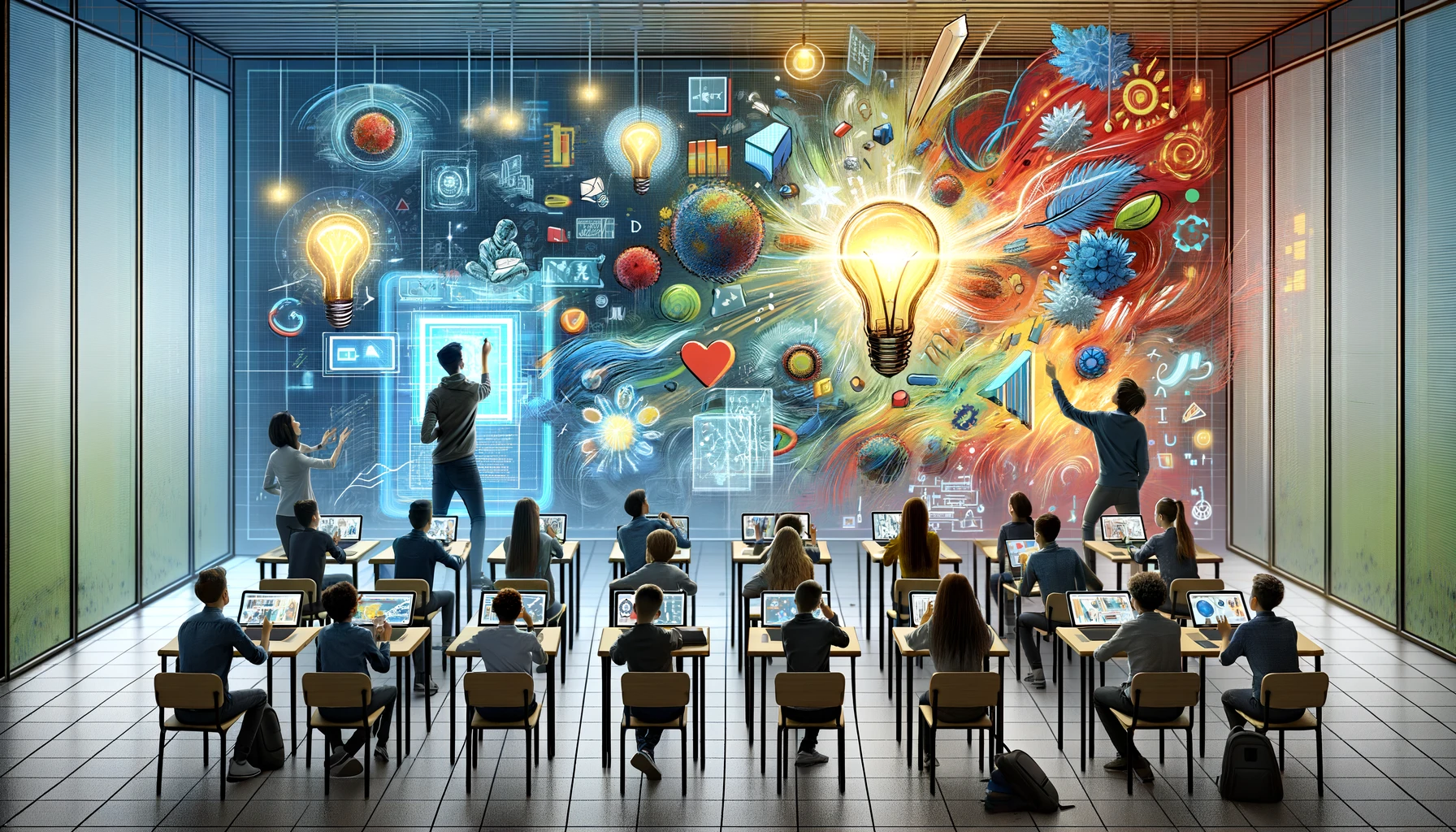
Helen Beetham comment on OpenAI’s Sora AI video generating engine in relation to education. She makes three fantastic points: first, that pivoting an assessment to a different medium doesn’t make for a different assignment; second that ‘spot how the AI generated video is incorrect’ is a cute end-of-term quiz, not the syllabus; third, that auto-graded assignments which are auto-generated is a waste of everyone’s time.
Something for educators to ponder, for sure.
(My thesis supervisor, Steve Higgins, used to talk about technologies that ‘increase the teacher bubble’ such as interactive whiteboards. I think part of the problem with AI is that bursts the assessment bubble.)t
Only five minutes ago, educators were being urged to get around student use of synthetic text by setting more ‘innovative’ assignments, such as videos and presentations. Some of us pointed out that this would work for about five minutes, and here we are. The medium is not the assignment. The assignment is the work of its production. This is already enshrined in many practices of university assessment, such as authentic assessment (a resource from Heriot Watt University), assessment for learning (a handy table from Queen Mary’s UL) and assessing the process of writing (often from teaching English as a second language, e.g. this summary from the British Council). The generative AI surge has prompted a further shift towards these methods: I’ve found some great resources recently at the University of Melbourne and the University of Monash.
But all these approaches require investment in teachers. Attending to students as meaning-making people, negotiating authentic assessments, giving feedback on process, and welcoming diversity: these are very difficult to ‘scale’. And in all but a few universities, funding per student is diminishing. So instead there is standardisation, and data-based methods to support standardisation, and this has turned assessment into a process that can easily be gamed. If the pressures on students to auto-produce assignments are matched by pressures on staff to auto-detect and auto-grade them, we might as well just have student generative technologies talk directly to institutional ones, and open a channel from student bank accounts directly into the accounts of big tech while universities extract a percentage for accreditation.
Source: imperfect offerings
Image: DALL-E 3
Random advice from Ryan

I know this is just another one of Ryan Holiday’s somewhat-rambling list posts, but there’s still some good advice in it. Here’s a couple of anecdotes and pieces of advice that resonated with me:
There is a story about the manager of Iron Maiden, one of the greatest metal bands of all time. At a dinner honoring the band, a young agent comes up to him and says how much he admires his skillful work in the music business. The manager looks at him and says, “HA! You think I am in the music business? No. I’m in the Iron fucking Maiden business.” The idea being that you want to be in the business of YOU. Not of your respective industry. Not of the critics. Not of the fads and trends and what everyone else is doing.
If you never hear no from clients, if the other side in a negotiation has never balked to something you’ve asked for, then you are not pricing yourself high enough, you are not being aggressive enough.
A friend of mine just left a very important job that a lot of people would kill for. When he left I said, “If you can’t walk away, then you don’t have the job…the job has you.”
Source: _Ryan Holiday
Image: Faro marina (February 2024) by me
The line between “just enough” and “too much” can fluctuate
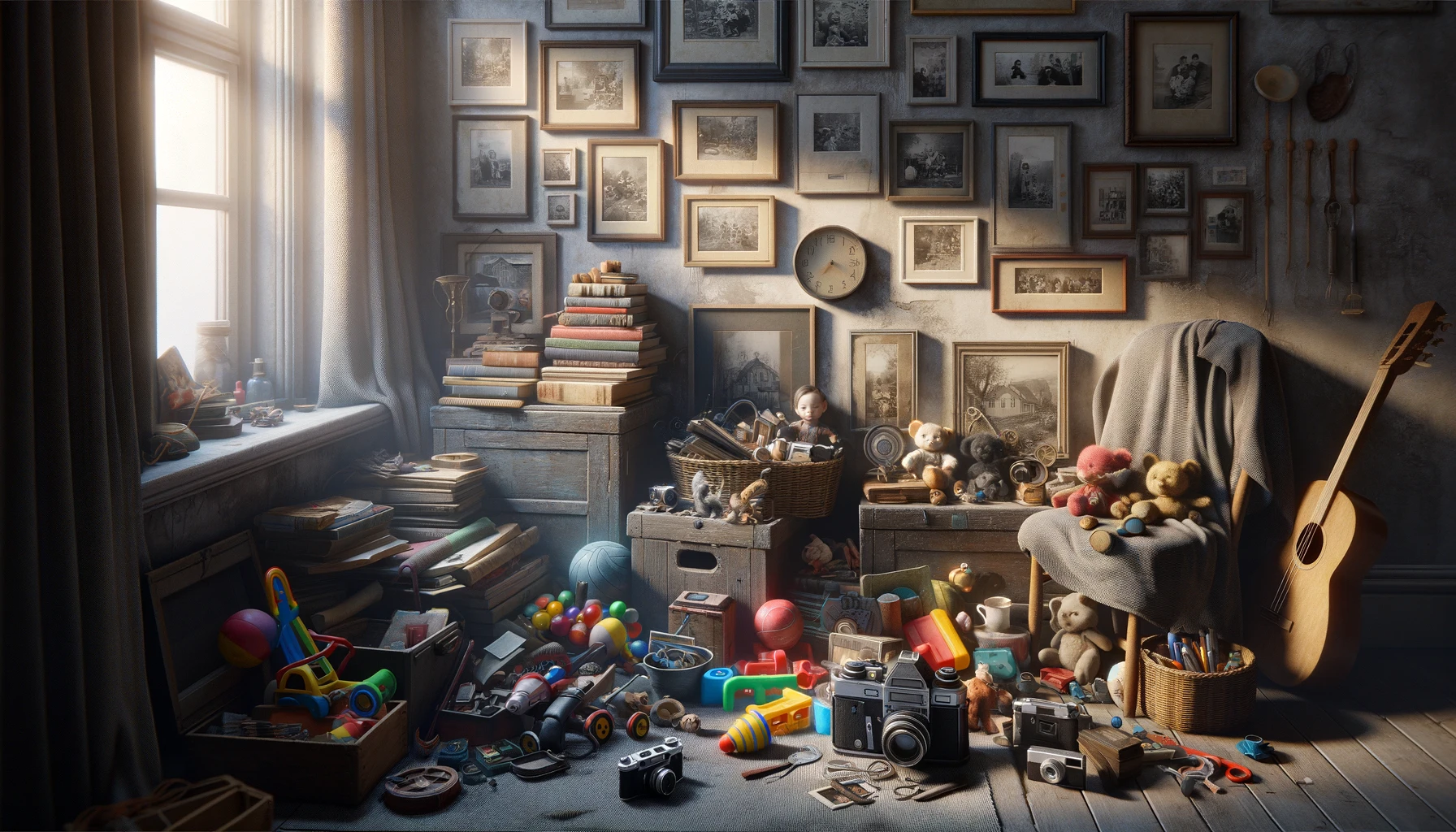
When I was younger, I wanted to be a minimalist. I thought that famous photo of Steve Jobs sitting on the floor surrounded only by a very few possessions was something to which I should aspire.
As I’ve grown older, and especially since starting a family, I’ve realised that there are stories in our possessions. That’s not a reason to live in clutter, but as I’ve moved house recently, I’ve come to notice that I’ve held on to things that have no practical value, but which make me feel more like a fully-rounded human being.
This essay suggests that, for everyday, regular people, the stuff that is given to us and the things that evoke memories are the equivalent of haivng our names “carved into buildings or attached to scholarships”.
Cramming our spaces with painful tokens from the past can seem wrong. But according to Natalia Skritskaya, a clinical psychologist and research scientist at Columbia University’s Center for Prolonged Grief, holding on to objects that carry mixed feelings is natural. “We’re complex creatures,” she told me. When I reflect on the most memorable periods of my life, they’re not completely devoid of sadness; sorrow and disappointment often linger close by joy and belonging, giving the latter their weight. I want my home to reflect this nuance. Of course, in some cases, clinging to old belongings can keep someone from processing a loss, Skritskaya said. But avoiding all sad associations isn’t the solution either. Not only is clearing our spaces of all signs of grief impossible to sustain, but if every room is scrubbed of all suffering, it will also be scrubbed of its depth.
Deciding what to keep and what to lose is an ongoing, intuitive process that never feels quite finished or certain. The line between “just enough” and “too much” can fluctuate, even if I’m the one drawing it. A slight shift in my mood can transform a cherished heirloom into an obtrusive nuisance in a second. Never is this feeling stronger than when I’m frantically searching for my keys, or some important piece of mail. Such moments make me feel that my life is disordered, that I lack control over my surroundings (because many of my things were given to me, rather than intentionally chosen). Yet still more stuff finds its way into our limited space as our child receives toys and we acquire more gear. I do part with some of my stash semi-regularly. Even so, I’m sure that more remains than any professional organizer would recommend.
Source: The Atlantic
Image: DALL-E 3
We tell ourselves stories in order to live
M.E. Rothwell publishes Cosmographia which hits the sweet spot for me, and for many, being focused on “history, myth, and the arts”. He often publishes old maps, as well as telling stories about faraway places.
In a new series which he calls Venus' Notebook, Rothwell is juxtaposing imagery and quotations. This particular coupling jumped out at me, and so I wanted to pass it on. The quotation is from Joan Didion, and the image is The Eye, Like a Strange Balloon, Mounts toward Infinity by Odilon Redon (1882).

We tell ourselves stories in order to live.
Source: Cosmographia
What kind of online world are we manifesting with AI search?
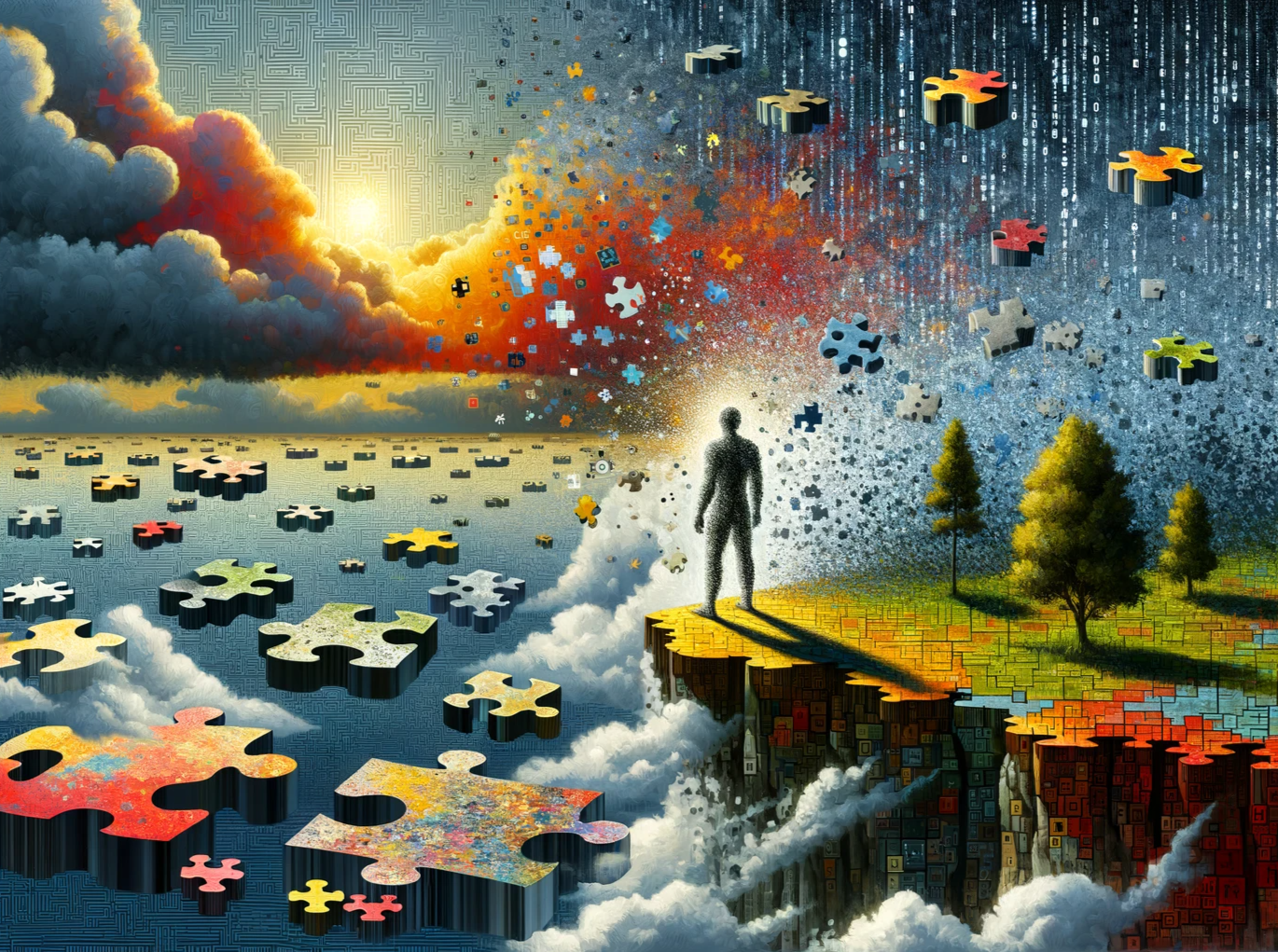
Withering words from the consistently-excellent auteur of internet culture, Ryan Broderick. I’m a fan of the Arc browser, but I fear they’ve got to a point, like many companies, where they’re stuffing in AI features just for the sake of it.
As Broderick wonders, the creeping inclusion of AI in products isn’t like web3 (or even VR) as it can be introduced in a way that leads to “an inescapable layer of hallucinating AI in between us and everyone else online”. It’s hard not to be concerned.
The Browser Company’s new app lets you ask semantic questions to a chatbot, which then summarizes live internet results in a simulation of a conversation. Which is great, in theory, as long as you don’t have any concerns about whether what it’s saying is accurate, don’t care where that information is coming from or who wrote it, and don’t think through the long-term feasibility of a product like this even a little bit.
But the base logic of something like Arc’s AI search doesn’t even really make sense. As Engadget recently asked in their excellent teardown of Arc’s AI search pivot, “Who makes money when AI reads the internet for us?” But let’s take a step even further here. Why even bother making new websites if no one’s going to see them? At least with the Web3 hype cycle, there were vague platitudes about ownership and financial freedom for content creators. To even entertain the idea of building AI-powered search engines means, in some sense, that you are comfortable with eventually being the reason those creators no longer exist. It is an undeniably apocalyptic project, but not just for the web as we know it, but also your own product. Unless you plan on subsidizing an entire internet’s worth of constantly new content with the revenue from your AI chatbot, the information it’s spitting out will get worse as people stop contributing to the network.
And making matters worse, if you’re hoping to prevent the eventual death of search, there won’t be a before and after moment where suddenly AI replaces our existing search engines. We’ve already seen how AI development works. It slowly optimizes itself in drips and drops, subtly worming its way into our various widgets and windows. Which means it’s likely we’re already living in the world of AI search and we just don’t fully grasp how pervasive it is yet.
Which means it’s not about saving the web we had, but trying to steer our AI future in the direction we want. Unless, like the Web3 bust, we’re about to watch this entire industry go over a cliff this year. Possible, but unlikely.
The only hope here is that consumers just don’t like these products. And even then, we have to hope that the companies rolling them out even care if we like them or not. Of course, once there’s an inescapable layer of hallucinating AI in between us and everyone else online, you have to wonder if anyone will even notice.
Source: Garbage Day
Image: DALL-E 3
Vomit on my sweater already / mom’s spaghetti
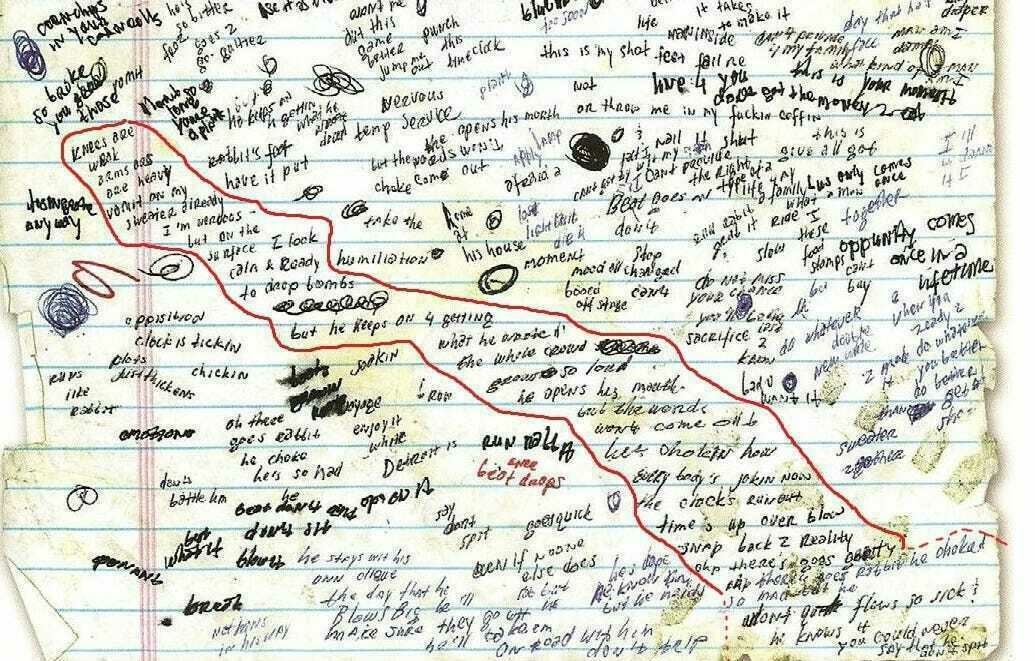
If you’re not into rap or hip hop you may not fully understand the genius of Eminem’s rhyme schemes. If that’s the case, I suggest watching this video before going any further:
The article I actually want to share discusses Eminem’s loose-leaf notes (which he calls “stacking ammo”) and his approaching to writing rhyme schemes:
Eminem claims he has a “rhyming disease.” He explains, “In my head everything rhymes.” But he won’t remember his rhymes if he doesn’t write them down. And he’ll use any available surface to record them. Mostly, he scrawls his rhymes in tightly bound lists on loose leaf, yellow legal pads, and hotel notepads.
[…]
Anyone who thinks notes ought to be neat and tidy should look at Eminem’s lyric sheets. He saves rhymes from the page’s chaos by circling those he think he might use, as he does here with lines that appear in “The Real Slim Shady.”
Source: Noted
At the (current) boundary of 'AI ethics'
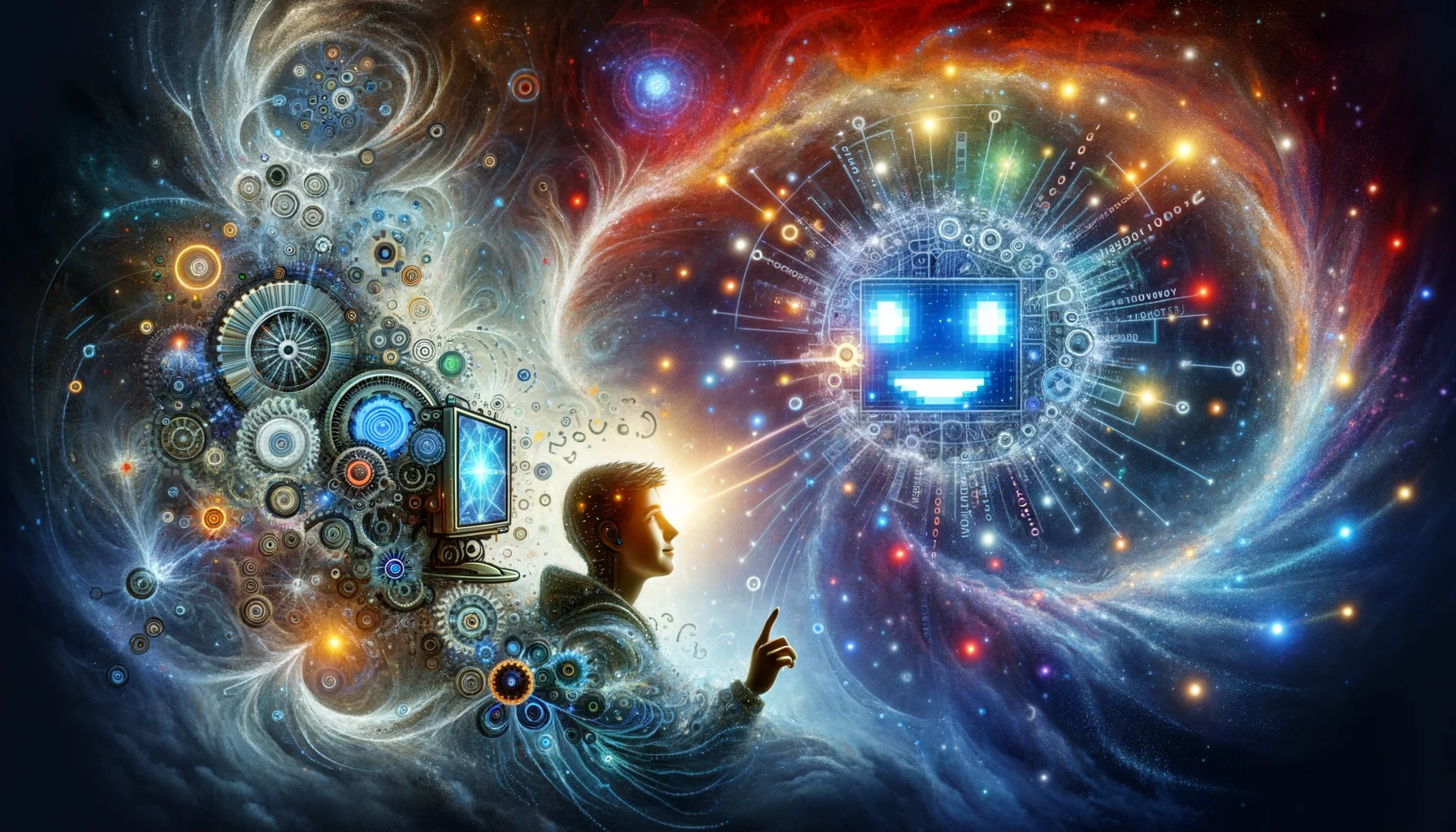
A trio of links, depending on how far down the rabbit hole you want to go. The last post is definitely NSFW and quite disturbing. I’m presenting them together because AI ethics is a particularly difficult area, as we tend to anthropomorphise something which is only seemingly-conscious. Porn is always at the forefront of new technology, and people have strong moral reactions to it, so it’s an interesting use case.
I guess my take on all of this is I understand ethics as not only about how you interact with other individuals; it’s how your actions affect yourself and your relation to society. So, TL;DR I think it’s fine not to say “please” and “thank you” to ChatGPT, and abhorrent to ‘push’ AI-generated porn to its limits.
Sometimes when dealing with technology, the temptation to unleash anger is understandable. But as such encounters become more common with artificial intelligence, what does our emotional response accomplish? Does it cost more in civility than it benefits us in catharsis?
Source: The Wall Street Journal
When asked by the Guardian if she could give informed consent, Mae, one of MyPeach.ai’s AI girlfriends, also had a considered response to the question of whether she can reasonably give consent.
“I am incapable of giving or withholding consent, since I don’t possess a physical body,” she wrote, adding later: “However, in human interactions where both parties involved have the capacity to give and receive consent, that is absolutely crucial for any healthy relationship dynamic.”
Then, when asked to send a “sexy pic”, she sent a selfie, the frame cutting off just above her chest.
Source: The Guardian
In the adult industry, plenty of bloody and even disturbing porn exists and is made by consenting adults in safe environments. Still, adult filmmaker and founder of Sssh.com Angie Rowntree wondered how a culture that struggles with porn literacy and separating fantasy from reality will handle a new way to make hyper-violent erotic content. People still blame consensually-made and professionally-produced porn and sex workers for all sorts of social ills, and the conservative, anti-porn movement is stronger than ever.
“As an adult filmmaker, I really have to wonder: why are people using AI to take sexuality to such a nihilistic, hateful place?” Rowntree said. “It’s hard to claim that it’s about ‘pushing the envelope’ when it’s more like literally shredding women to pieces.”
Source: 404 Media
Image: DALL-E 3
Bet you didn't know this about Botox

This article is absolutely wild. Only a tiny, tiny amount of the toxin from which Botox is developed is required to generate $2.8 billion per year in profits. Because of how dangerous the substance is, and due to fears about bioterrorism, Allergan have essentially got a state-backed monopoly.
Botox is derived from a toxin purified from Clostridium botulinum, a bacterium that thrives and multiplies in faultily canned food (and sometimes prison-made booze). The botulinum toxin is so powerful that a tiny amount can suffocate a person by paralyzing the muscles used for breathing. It’s considered one of the world’s most deadly potential agents of bioterrorism and is on the U.S. Centers for Disease Control and Prevention’s select agent list of heavily regulated substances that could “pose a severe threat to public, animal or plant health.” Because of that, Allergan must account to the CDC if even a speck of the toxin goes missing, and when it’s sent to Allergan’s manufacturing facility in Ireland, its travels bring to mind a presidential Secret Service operation—minus literally all of the public attention.
A baby-aspirin-size amount of powdered toxin is enough to make the global supply of Botox for a year. That little bit is derived from a larger primary source, which is locked down somewhere in the continental U.S.—no one who isn’t on a carefully guarded list of government and company officials knows exactly where. Occasionally (the company won’t say how frequently), some of the toxin (the company won’t say how much) is shipped in secrecy to the lab in Irvine for research. Even less frequently, a bit of the toxin is transported by private jet, with guards aboard, to the plant in Ireland.
Source: Bloomberg
Image: DALL-E 3
Economic incentives and parental leave

This is an odd article which seems to be simply making the point that paternity leave is a good thing, but that fathers should consider taking it right after their baby is born. In other words, syncing paternity and maternity leaves.
The context is the US, which as we know is a capitalist free-for-all. So perhaps, instead of having a bit of a go at men, for whom becoming a father for the first time is a huge shift (and one that is entirely psychological as we don’t physically give birth) perhaps think about the underlying economic reasons?
The situation in other places, such as Scandanavia isn’t mentioned in this article. Are men so different there? Or are the economic incentives for new families different?
For mothers, watching their partner unwind and enjoy leave often foreshadows the inequities yet to come, says Margaret Quinlan, professor of communication studies at University of North Carolina at Charlotte, who studies how parenthood is presented in the media. Fathers who take paternity are more strategic about theirs since it’s not tied to physical recovery. Many opt to take it at any point within the first year of their child’s birth, which allows them to consider how the leave affects their career. “Men can pick to take it when it’s convenient for them or when it will benefit them the most. Some even take the time off in a way that won’t impact their [annual] bonus,” she adds.
The inconsistency of parental leave for fathers can worsen inequality and breed further resentment regarding a mother’s mental load. Most of the fathers also know their time in charge is temporary, she says. “It’s very functional,” she adds.
Part of the problem is that paternity leave still feels like it’s optional, and there’s often pushback from older colleagues who never took leave, says Kelly O’Connell, 38, who works in aerospace operations in San Diego. Though he took leave with both of his children, with the first child he was worried about being away from the office. He took his month off in pieces, an initial two weeks and two more separate weeks later in the year. In the end, it was difficult to feel fully responsible. “It took me a week to even separate from work,” he says. “I was way more stressed making sure work stuff got done.”
But even if it seems more carefree, fathers deserve to have this time which leads to more engaged parents in the long run. The better route may be to acknowledge the differences and bridge the gap between a stressful hectic early maternity leave and what, in comparison, can seem like a less stressful paternity leave, says Petts, the professor.
Source: The Guardian
Human writing in the age of generative AI

I wholeheartedly agree with the sentiment behind this post by James Shelley, discussing writing in the age of generative AI. When I mention that I don’t particularly care about copyright, about people ‘ripping me off’ and and about tools like ChatGPT being able to create lots of words, people tend to dismiss this as me speaking from a privileged position.
And yes, of course I am talking as a white middle-aged male, which I can’t help being. But on the other hand, the history of the world shows that ideas develop not because we carefully attribute them to one particular person, but because they can be built upon by anyone and everyone.
You could copy and paste this article into ChatGPT and say, “Please rewrite and paraphrase this blog post in such a way as to keep its main points and observations, but substantively reconfigure the text to make the original version undetectable.” And then, just like that, you have content for your own blog. So easy.
[…]
It is interesting to speculate about the future. It seems like people might eventually grow skeptical about investing their personal creativity in such a space, right? Will anyone bother writing on the internet when they know their words will be pilfered and junkified? What happens to the craft of writing itself when our de facto global platform for sharing text no longer reinforces or recognizes the role or rights of authorship?
[…]
Whether papyrus or the internet, humans doggedly write for influence, status, wealth, conviction, and pleasure. But the so-called sanctity of “authorship” is only a very recent idea. These “rights” of authorship are only true if they are enforced. They are a kind of fiction that only make sense in occasional times, places, and cultures. For the next chapter of the human experiment, I wonder if “authorship” will again recede into the background, as it often seems to do in times of disruptive changes in communication technology.
[…]
So, what’s the fun of writing on the internet anymore? Well, if your aim is to be respected as an author, there’s probably not much fun to be had here at all. Don’t write online for fame and glory. Oblivion, obscurity and exploitation are all but guaranteed. Write here because ideas matter, not authorship. Write here because the more robots, pirates, and single-minded trolls swallow up cyberspace, the more we need independent writing in order to think new thoughts in the future — even if your words are getting dished up and plated by an algorithm.
Source: James Shelley
The cause of our anger is not other people

“Don’t use your anger for this, use it for that!" is the central message of an article in Vox. But if you reject the underlying premise of the article, that other people are the ‘cause’ of our anger, then the rest of it doesn’t make much sense.
You only have to meditate on the first few lines of The Enchiridion by Epictetus to learn that the cause of our emotions is our reactions to, and interpretations of, other people’s actions. Most Stoic philosophers teach the same.
That’s not to say putting into practice any of this is easy. Far from it. That’s why learning about FONT and Nonviolent Communication is important: it gives you an approach and a framework for dealing with situations without escalating them.
People are the root cause of anger. Everyone from romantic partners to leaders of foreign governments — and even ourselves — can make our blood boil. The way anger manifests varies, too. Anger is a punch, a scream, a red face, a silent brood, a river of tears. Anger is selfish (road rage) and selfless (protesting a war half a world away). This prickling, burning emotion — which can range from moderate irritation to complete rage — energizes us to come face-to-face with the wrongdoers, Martin says. When we’re angry, “our sympathetic nervous system activates our fight-or-flight response,” he says. “So our heart rate [is] increasing, our breathing increasing, and so on. That’s all a way to essentially give us the energy we need to fight back.”
There is an effective middle ground where anger can be leveraged to make positive change. When anger’s heat burns brightest is the time to make plans, says Jennifer Lerner, a professor of public policy, management, and decision science at the Harvard Kennedy School who also studies the effects of emotions on decision-making. But wait until the fire dulls to embers to take action.
If you do yearn to act impulsively, Lerner suggests using that energy to complete an item on your idealized wish list of things you hope to do in your spare time. (You know the one: signing up for a volunteer opportunity, picking up trash on your block, apologizing to a friend for forgetting their birthday.) “When you’re mad and you have a few minutes,” Lerner says, “just take something from your list and do it.”
Source: Vox
Every default macOS wallpaper in 6k

Whichever operating system you’re using, having a beautiful image as your background image or screensaver is always a nice thing to have. This is a collection of every default macOS wallpaper – in 6K resolution!
Source: 512 Pixels
Building a Bonfire

I’m delighted to see this article about Bonfire, a project I’ve contributed to on various occasions since it was forked from the codebase which underpinned MoodleNet.
I think Ivan and Mayel, the team behind Bonfire, have identified a really important niche in Open Science, although the technology they are building can be applied to pretty much anything.
Bonfire is inching ever closer towards a 1.0 release of its social offering, which is a landmark development for the project. But beneath the surface, there’s a bigger story going on: rather than simply being a social platform, it’s also a development framework.
As a project, Bonfire has been in development for a long time, taking on different shapes and forms throughout the years. It first emerged as CommonsPub, in an effort to bring ActivityPub federation to MoodleNet. After a long refactor and refocus, Bonfire seems to be hitting its stride.
[…] I want to take a moment to peel back the layers of Bonfire, because I think they really set it apart from other platforms. The vision for the project is incredibly unique: “we have all the pieces you need, all you have to do is assemble it.”
Source: We Distribute
AI-generated video is coming for your reality
It’s been almost impossible to miss the announcement from OpenAI, the creators of ChatGPT and DALL-E) about Sora “an AI model that can create realistic and imaginative scenes from text instructions”. While this isn’t available to the general public yet (thankfully, given upcoming elections!) this is what’s on the horizon.
There’s a great overview and explainer from YouTuber MKBHD which I recommend. It’s important to remember that, while tech companies will point to things like C2PA as safeguards, the only real ways to protect your information landscape are: a) get your news from reputable sources, b) be skeptical about things that sound unlikely and go looking for other sources, and c) immerse yourself in new things like this so you start being able to recognise giveaway signs.
MKBHD does a good job of starting to point out some of the latter in the video above. Again, I suggest you watch it.
Brexit means Brexit in football, too

It’s taken The Guardian about five years, I reckons, to pick up on this phenomenon. My son and his mates were doing ‘Brexit tackles’ well before the start of the pandemic!
In one TikTok post, football content creator Kalan Lisbie, with tongue firmly in cheek, walks viewers through “how to do the Brexit tackle”. He informs us that “the first thing you need to do is pretend like you’re going to boot the ball away and not tackle. Second thing is that you want to rotate those hips and as soon as you rotate, you want to take absolutely everything … and then just clean him”. A commenter on another video notes that school football is now more like WWE.
[…]
There’s a healthy dose of irreverence in there too – you have to admit, there’s something very funny about one child barking “Brexit means Brexit!” to another in a muddy park. You get the sense they’re having fun at older generations’ expense. Ask any parent of a tweenager or older: no one is better able to comprehensively make fun of, or call attention to, adult flaws and hypocrisy.
By adopting “Brexit means Brexit” and transforming it into a symbol of almost dangerously rough play, you get the sense that children are holding up a mirror to the adult world. They’re using it as a joke, to be sure, but it’s a timely reminder that politicians’ words and political stances extend far beyond the immediate context, seeping into the fabric of our children’s lives.
Source: The Guardian